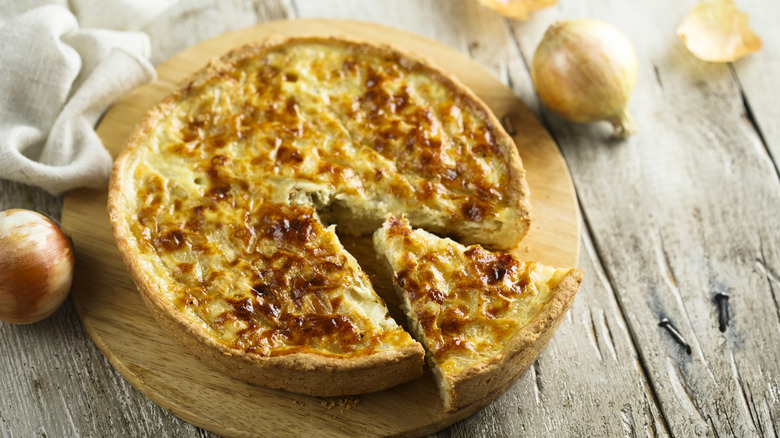The History Of Quiche Dates Back To Medieval Germany
Coq au vin. Croque Monsieur. Quiche. They are all typical French foods, right? Not so fast. Despite its decidedly French name — it has a certain je ne sais quoi, n'est pas? — the savory egg-based tart originated in Germany. That's right. The mainstay on traditional French brasserie menus that goes head-to-head with other classic café dishes like Anthony Bourdain's favorite steak frites is a German creation.
Quiche originated in a region that bounced back and forth between German and French control for centuries. Under German rule, the territory was known as Lothringer. When France was in command, it was called Lorraine. Speck is the German word for bacon. Quiche is a derivation of the German word kuchen, meaning cake. Add it all up and it makes sense that the dish we know now as quiche Lorraine is a French take on German Lothringer speckkuchen, a hearty and inexpensive peasant food made with eggs, bacon, and cream.
There are some differences. The original German version is more cake-like than modern-day quiche. In Lothringer, and in other regions of Germany, speckkuchen is made with bread dough — often rye — resulting in a heavier, more filling dish. And, for the record, early versions of both quiche and speckkuchen were cheeseless. It's unclear exactly when, but suffice it to say cheese didn't sneak into the mix until much later — and it's still a point of contention among quiche purists.
Overexposure almost killed quiche
While quiche — or speckkuchen depending on whether you're in France or Germany — remained a local favorite for centuries, it took a while for the rest of the world to catch on. That began to change during World War II when British soldiers who had served in eastern France brought back tales of the bacon flan in a delicate crust. From Great Britain, it was a short hop to the United States. By the 1950s, quiche was becoming a staple go-to dish for everything from buffets to light suppers. Feature articles in magazines like Cosmopolitan, Ladies Home Journal, and Good Housekeeping helped spread the word and in 1963, Julia Child sealed the deal when she showcased quiche during the first season of her long-running television show, "The French Chef."
Then things turned. Like disco music in the '70s, quiche became the punching bag of the food world. Plagued by reports of high fat count and cholesterol (eggs were unfairly demonized for a few decades in the 20th century), quiche was suddenly the subject of disdain, even ridicule. A 1982 book titled "Real Men Don't Eat Quiche" didn't help matters. The satirical trope, a tongue-in-cheek ode to the (happily outdated) late-20th-century definition of a manly man, cursed the quiche. "Real" men took the author's irreverence as truth — ironic given that it originated in Germany as a hearty dish. Happily, societal disdain for quiche was short-lived. Quiche, in all its simple goodness, made a comeback in short order.

